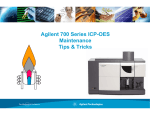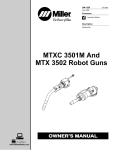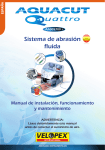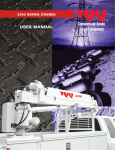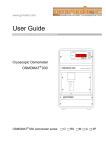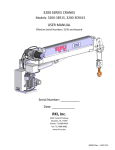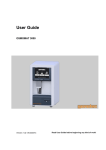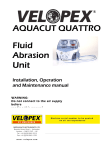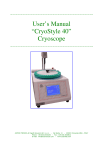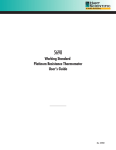Download 5924-5929 Users Guid..
Transcript
Hart Scientific 5924–5929 Metal Freeze Point Cell User’s Guide Rev. 5A2101 Fluke Corporation Hart Scientific Division 799 E. Utah Valley Drive American Fork, UT 84003-9775 USA Phone: +1.801.763.1600 Telefax: +1.801.763.1010 Email: [email protected] www.hartscientific.com Subject to change without notice. Copyright © 2005 Printed in USA Rev. 5A2101 Table of Contents 1 Before You Start . . . . . . . . . . . . . . . . . . . . . . . . . . 1 1.1 1.2 Symbols Used . . . . . . . . . . . . . . . . . . . . . . . . . . . . 1 Safety Information . . . . . . . . . . . . . . . . . . . . . . . . . . 2 1.2.1 1.2.2 1.3 Warnings . . . . . . . . . . . . . . . . . . . . . . . . . . . . . . . . . . . . . 2 Cautions . . . . . . . . . . . . . . . . . . . . . . . . . . . . . . . . . . . . . 2 Authorized Service Centers. . . . . . . . . . . . . . . . . . . . . . 3 2 Introduction . . . . . . . . . . . . . . . . . . . . . . . . . . . . 5 3 Specifications . . . . . . . . . . . . . . . . . . . . . . . . . . . . 7 4 Description . . . . . . . . . . . . . . . . . . . . . . . . . . . . . 9 5 Care of Your Metal Freezing Point Cell. . . . . . . . . . . . . 11 5.1 5.2 General Information . . . . . . . . . . . . . . . . . . . . . . . . . 11 Devitrification of Quartz Glass . . . . . . . . . . . . . . . . . . . 11 6 Realization of the Freezing Point . . . . . . . . . . . . . . . . 13 6.1 Unpacking . . . . . . . . . . . . . . . . . . . . . . . . . . . . . . 13 6.2 Assembly Guide 6.3 6.4 6.5 . . . . . . . . . . . . . . . . . . . . . . 14 Background Information . . . . . . . . . . . . . . . . . . . . . . 15 Maintaining the cell with argon . . . . . . . . . . . . . . . . . . . 23 Vertical temperature gradient and controller accuracy adjustment . 24 6.5.1 6.5.2 Vertical temperature gradient adjustment. . . . . . . . . . . . . . . . . . . . 24 Controller display accuracy adjustment. . . . . . . . . . . . . . . . . . . . . 24 6.6 Procedure for realizing the freeze (In, Zn, Al, Ag, and Cu fixed points) 25 6.6.1 6.6.2 6.6.3 6.6.4 6.6.5 6.6.6 6.7 Realization of the freezing point of In . Realization of the freezing point of Sn . Realization of the freezing point of Zn . Realization of the freezing point of Al . Realization of the freezing point of Ag . Realization of the freezing point of Cu . . . . . . . . . . . . . . . . . . . . . . . . . . . . . . . . . . . . . . . . . . . . . . . . . . . . . . . . . . . . . . . . . . . . . . . . . . . . . . . . . . . . . . . . . . . . . . . . . . . . . . . . . . . . . . . . . . . . . . . . . 25 26 27 29 30 32 SPRT Care At High Temperatures . . . . . . . . . . . . . . . . . 33 7 The correction for the pressure difference . . . . . . . . . . . 35 i Figures Figure 1 Figure 2 Figure 3 Figure 4 Figure 5 Figure 6 Figure 7 Figure 8 Figure 9 ii Metal Freezing Point Cell . . . . . . . . . . . . . . . . . . . . . . . . . 6 The Hart open metal freezing point cell. . . . . . . . . . . . . . . . . . 15 9114 Furnace Interior with Freeze Point Cell, Cross Sectional View. . . 16 9115 Furnace Interior with Freeze Point Cell, Cross Sectional View. . . 17 9116 Furnace Interior View . . . . . . . . . . . . . . . . . . . . . . . 18 The metal freezing point cell in the cell containment vessel (basket). . . 20 Freezing curve comparison of one cell. . . . . . . . . . . . . . . . . . 21 Two liquid-solid interfaces in the cell. . . . . . . . . . . . . . . . . . . 22 A typical freezing curve for the Zinc Cell . . . . . . . . . . . . . . . . 29 Tables Table 1 Table 2 Table 3 Table 4 Table 5 Table 6 Table 7 International Electrical Symbols . . . . . . . . . . . . . . . . . . . . . 1 The defining metal freezing points of the ITS-90, pressure constants, and resistance ratios. . . . . . . . . . . . . . . . . . . . . . . 5 Some subranges of the ITS-90 and freezing points required for calibration. . . . . . . . . . . . . . . . . . . . . . . . . . . . . . . . 6 The specification of metal freezing point cells. . . . . . . . . . . . . . . 7 Summary of the 1st Cryoscopic Constants and the Estimated Effects of Impurities . . . . . . . . . . . . . . . . . . . . . . . . . . . 19 The furnaces for fixed points and their temperature uniformity.. . . . . 23 Coefficients for the pressure difference of some defining fixed points. . 35 iii 1 Before You Start Symbols Used 1 1.1 Before You Start Symbols Used Table 1 lists the International Electrical Symbols. Some or all of these symbols may be used on the instrument or in this manual. Table 1 International Electrical Symbols Symbol Description AC (Alternating Current) AC-DC Battery CE Complies with European Union Directives DC Double Insulated Electric Shock Fuse PE Ground Hot Surface (Burn Hazard) Read the User’s Manual (Important Information) Off On 1 5924–5929 Metal Freeze Point Cell User’s Guide Symbol Description Canadian Standards Association OVERVOLTAGE (Installation) CATEGORY II, Pollution Degree 2 per IEC1010-1 refers to the level of Impulse Withstand Voltage protection provided. Equipment of OVERVOLTAGE CATEGORY II is energy-consuming equipment to be supplied from the fixed installation. Examples include household, office, and laboratory appliances. C-TIC Australian EMC Mark The European Waste Electrical and Electronic Equipment (WEEE) Directive (2002/96/EC) mark. 1.2 Safety Information Use this instrument only as specified in this manual. Otherwise, the protection provided by the instrument may be impaired. The following definitions apply to the terms “Warning” and “Caution”. • “Warning” identifies conditions and actions that may pose hazards to the user. • “Caution” identifies conditions and actions that may damage the instrument being used. 1.2.1 Warnings To avoid personal injury, follow these guidelines. • DO NOT use this instrument to measure the temperature of any hazardous live component. • DO NOT use this unit for any application other than calibration work. • DO NOT use this unit in environments other than those listed in the user’s manual. • Use of this instrument at high temperatures for extended periods of time can cause the handle to become hot. • Follow all safety guidelines listed in the user’s manual. • Calibration Equipment should only be used by Trained Personnel. 1.2.2 Cautions To avoid possible damage to the instrument, follow these guidelines. • DO NOT remove the label from the handle. This cautions the user concerning the delicate nature of the instrument. 2 1 Before You Start Authorized Service Centers • DO NOT drop or bang the probe in any way. This will cause damage to the probe internally and affect its calibration. • Read Section entitled “PRT Care and Handling Guidelines” before removing the PRT from the shipping box or case. Incorrect handling can damage the PRT and void the warranty. • Keep the shipping container in case it is necessary to ship the PRT. Incorrect packaging of the PRT for shipment can cause irreparable damage. 1.3 Authorized Service Centers Please contact one of the following authorized Service Centers to coordinate service on your Hart product: Fluke Corporation, Hart Scientific Division 799 E. Utah Valley Drive American Fork, UT 84003-9775 USA Phone: +1.801.763.1600 Telefax: +1.801.763.1010 E-mail: [email protected] Fluke Nederland B.V. Customer Support Services Science Park Eindhoven 5108 5692 EC Son NETHERLANDS Phone: +31-402-675300 Telefax: +31-402-675321 E-mail: [email protected] Fluke Int'l Corporation Service Center - Instrimpex Room 2301 Sciteck Tower 22 Jianguomenwai Dajie Chao Yang District Beijing 100004, PRC CHINA 3 5924–5929 Metal Freeze Point Cell User’s Guide Phone: +86-10-6-512-3436 Telefax: +86-10-6-512-3437 E-mail: [email protected] Fluke South East Asia Pte Ltd. Fluke ASEAN Regional Office Service Center 60 Alexandra Terrace #03-16 The Comtech (Lobby D) 118502 SINGAPORE Phone: +65 6799-5588 Telefax: +65 6799-5588 E-mail: [email protected] When contacting these Service Centers for support, please have the following information available: • Model Number • Serial Number • Complete description of the problem 4 2 Introduction 2 Introduction The International Temperature Scale of 1990 (ITS-90) is based on a series of defining fixed points. At temperatures above 273.16 K, most of the fixed points are the freezing points of specified pure metals. Pure metals melt and freeze at a unique temperature through a process involving the absorption or liberation of the latent heat of fusion. A metal freezing point is the phase equilibrium between the liquid phase and solid phase of a pure metal at a pressure of one standard atmospheric pressure (101,325 Pa). The freezing points of indium, tin, zinc, aluminum, silver, gold, and copper are the defining fixed points of the ITS-90. The temperature values of these freezing points assigned by the ITS-90, the pressure effect constants and the resistance ratios are listed in Table 2. Table 2 The defining metal freezing points of the ITS-90, pressure constants, and resistance ratios. Pressure Effect of Fixed Points ASSIGNED TEMPERATURE dt/dP dt/dh (10-3K/m) dWr/dt FIXED POINT T90 (K) t90 (°C) (10-8K/Pa)† Wr (T90) ( x 0.001) FP In 429.7485 156.5985 4.9 3.3 1.60980185 3.801024 FP Sn 505.078 231.928 3.3 2.2 1.89279768 3.712721 FP Zn 692.677 419.527 4.3 2.7 2.56891730 3.495367 FP Al 933.473 660.323 7.0 1.6 3.37600860 3.204971 FP Ag 1234.93 961.78 6.0 5.4 4.28642053 2.840862 FP Au 1337.33 1064.18 6.1 10 -- -- FP Cu 1357.77 1084.62 3.3 2.6 -- -- †Equivalent to millikelvins per standard atmosphere. All of these fixed points are intrinsic temperature standards according to the definition of the ITS-90. In certain conditions these freezing points are highly reproducible obtaining almost the same temperature wherever and whenever a freezing point is realized. The difference among different realizations of a freezing point might be well within 1.0 mK for the freezing points of indium, tin and zinc; within a few millikelven for the freezing points of aluminum and silver. For your convenience Hart has developed several different designs of fixed-point cells for the realization of the freezing points. Hart has open fixed-point cells for those who desire work with traditional fixed-points. Additionally, Hart has developed sealed cells in several configurations, which has made it easy to realize these fixed points. The 5900 series and 5910 series of fixed-point cells are completely-sealed cells. The 5920 series of cells are long cells with stainless steel caps and ports for pumping and filling argon gas. 5 5924–5929 Metal Freeze Point Cell User’s Guide Figure 1 Metal Freezing Point Cell These freezing points are indispensable for the calibration of a standard platinum resistance thermometer (SPRT). Different subranges require different sets of freezing points, as summarized in Table 3. Table 3 Some subranges of the ITS-90 and freezing points required for calibration. 6 SUBRANGE FREEZING POINTS REQUIRED 0°C–961.78°C FP Sn, FP Zn, FP Al, and FP Ag 0°C–660.323°C FP Sn, FP Zn, and FP Al 0°C–419.527°C FP Sn and FP Zn 0°C–231.928°C FP In and FP Sn 0°C–156.5985°C FP In 3 Specifications 3 Specifications Table 4 The specification of metal freezing point cells. Model Number Fixed Point 5924 5925 5926 5927 5928 Contact Hart 5929 FP In FP Sn FP Zn FP Al FP Ag FP Au FP Cu 0.15 - 0.3 0.2 - 0.4 0.2 - 0.4 0.6 - 1.0 1.0 - 2.0 1.0 - 2.0 2.0 - 4.0 0.7 0.5 0.9 1.3 2.4 2.5 10 99.9999% 99.9999% 99.9999% 99.9999% 99.9999% 99.9999% 99.9999% 0.97 0.96 0.95 0.35 1.35 Outer diameter of the cell (mm) 50 50 50 50 50 50 50 Overall height of the cell (mm) 596 596 596 596/696 696 696 696 Inner diameter of the well (mm) 8 8 8 8 8 8 8 195 195 195 195 195 195 195 Reproducibility (mK) Expanded uncertainty (mK), k=2 Metal Purity Quantity of metal (kg) Total immersion depth† (mm) †The 1.13 distance from the bottom of the re-entrant well to the upper surface of the metal Other sizes of cells are available according to the customer’s special requirement. 7 4 Description 4 Description A typical 592X Hart Scientific metal freezing point cell is shown in Figure 2 on page 15. A proper quantity of metal (See Table 3 for detail) with a purity of 99.9999% is melted into a graphite crucible with a graphite lid and re-entrant well. The impurity in the graphite is less than 5 PPM. All of the graphite parts are subjected to a high-temperature, high-vacuum treatment before loading the metal sample. It is important to avoid any possible contamination to the surface of the graphite parts during the manufacturing process. A graphite disk sits on the crucible. The assembled graphite crucible, with the high-purity metal, is then enclosed in a long quartz cell. Pure silica wool insulation is interspersed between graphite disks to act as a thermal barrier. The cell is sealed with a specially designed stainless steel cap with a port and vacuum valve. The cell is connected to a pumping and filling system and then drawn down to a proper pressure at a temperature near the freezing point for several days. During this period the cell is purged with high purity argon repeatedly to remove any absorption gas on the surface of all parts in the cell. Finally, the cell is filled with 99.999% pure argon at a pressure close to 101,325 Pa at room temperature and the vacuum valve closed. In providing the highest quality fixed-point cells on the market, Hart's experts carefully eliminate possible sources of errors. For example, sand-blasting the outer surface of the central re-entrant quartz well of the sealed cell decreases the radiation losses along the well to a minimum. A long immersion depth of the thermometer into the liquid metal makes any error due to the thermal conductivity along the thermometer sheath and leads negligible. 9 5 Care of Your Metal Freezing Point Cell General Information 5 5.1 Care of Your Metal Freezing Point Cell General Information The metal freezing point cell is an extremely delicate device. Great care must be taken in handling, using and transporting the cell. The quartz outer shell is easily broken. It is suggested that the cell be kept in the vertical position for safety, although putting a cool cell in the horizontal orientation for a short time period will not cause any damage. It is dangerous to transport the cell by general carrier, therefore, the cell should be hand-carried from one place to another place. It is extremely important to keep the outer surface of the cell clean to avoid devitrification of the quartz. Never touch the cell with bare hands. Whenever you have to handle the cell, always wear clean cotton gloves or use clean paper. If there is any chance that the outside of the cell has been touched with bare hands, clean the quartz with alcohol before inserting it into a furnace. 5.2 Devitrification of Quartz Glass Devitrification is a natural process with quartz glass materials. Quartz is utilized in a glass state. The most stable state for quartz is crystalline. Therefore, devitrification is the tendency of the quartz g lass to return to its most stable state. If the quartz glass is kept extremely clean and free of contamination, devitrification will occur only at high temperatures. The process occurs more rapidly at lower temperatures when the quartz glass has become contaminated by alkaline metals (Na, K, Mg, and Ca). The alkalis found in normal tap water can cause the process to start. There is conflicting opinion among the experts as to whether the process can be stopped. Some say that once the process starts it does not stop. Others indicate that once the alkali is removed, the process will stop. Removal of the devitrification is not practical as it requires drastic measures and is potentially dangerous to the instrument and/or the user. Devitrification starts with a dulling or opacity of the quartz glass. It develops into a rough and crumbling surface. Devitrification ultimately weakens the quartz glass until it breaks or is otherwise no longer useful. The best cure for contamination and devitrification is prevention. Being aware of the causes and signs of contamination can help the user take the steps necessary to control contamination of the cell. Keep your cell clean and avoid contact with bare hands, tap water, or contaminated SPRTs. 11 6 Realization of the Freezing Point Unpacking 6 Realization of the Freezing Point As was mentioned in Section 1, Introduction, it is not difficult to realize a freezing point by using the Hart Scientific metal freezing point cell. In order to get the highest possible accuracy, a general understanding of the freezing process of an ideal pure metal is helpful. 6.1 Unpacking Since it is difficult to hand carry or deliver an assembled 592X fixed point cell, the 592X fixed point cell must be delivered as a kit. The kit is comprised of the following parts: 1. Crucible assembly (sealed in a Pyrex vessel in dry pure argon atmosphere) 2. High-purity graphite disks, 6 pieces, sealed in a Pyrex vessel in dry pure argon atmosphere, same Pyrex vessel as for crucible assembly 3. Pure fused silica (quartz glass) wool disks (in a Pyrex tube) 4. Fused silica (quartz glass) outer shell, 1 piece 5. Fused silica (quartz glass) reentrant well, 1 piece 6. A clean Pyrex tube or rod (used as tool, and will not be assembled into the cell) 7. Extra-clean ash less filter papers (used during assembling) 8. Stainless steel (SS) cap assembly, 1 set, including the following parts (see fig. 2 in details, all of the parts were assembled loosely and packed in a polyethylene bag): • SS top cover, 1 piece • SS well clamp, 1 piece • SS cover clamp ring, 1 piece • Silicone O-ring 1.862 ID x .103w, 1 piece • Silicone O-ring .424 ID x .103w, 1 piece • Silicone seal washer (64 mm/50.6 mm x 5 mm), 1 piece • High vacuum bellow valve, NUPRO SS-4H, 1 piece • SS valve support bracket, 1 piece • Screw, 8-32 x 1 SKTHD CAP, 4 pieces • Screw, 4-40 x ¼ SKTHD CAP SST, 3 pieces • Screw, 8-32 x 5/16 PPHD, 2 pieces 13 5924–5929 Metal Freeze Point Cell User’s Guide 6.2 14 Assembly Guide 1. Assembly should be performed in a clean surrounding. It is suggested to put clean paper on a working table in a very clean room. Wear new clean gloves during assembling. The crucible assembly should only be touched by ash-less filter paper (provided). 2. Carefully break the top of the Pyrex vessel containing the crucible assembly and graphite disks with a clean metal tool. Take the graphite disks out of the Pyrex vessel and put them on a piece of ash less filter paper in a clean place. Because the crucible assembly was sealed in a pure and dry argon atmosphere to avoid possible contamination, break the Pyrex vessel only when you have made good preparation. Complete the entire assembling work in as short period as possible to avoid contamination and oxidation to pure metal. 3. Keep the cell fused silica outer shell (later we will call it as outer shell) at an angle about 10° to the horizontal direction; let the crucible assembly slide slowly and gently to the bottom of the outer shell. Use a piece of ash less filter paper to hold the crucible assembly during the process. Put one piece of graphite disk on the top of the crucible assembly. 4. Carefully take pure fused silica wool disks from Pyrex tube and put them into the outer shell using the Pyrex tube as a tool. Put more pure fused silica wool disks into the outer shell until the height of them to approximately 80 mm. 5. Put a piece of graphite disk into the outer shell on the top of pure fused silica wool disks. Push down the graphite disk until the height of pure fused silica wool disks decreases to approximately 40 mm using Pyrex tube and fused silica well as tools (Keep the surface of fused silica well clean during the entire assembling process, the fused silica well will be assembled into the cell finally). Insert the fused silica well through the holes of graphite disks and pure fused silica wool disks into the well of the crucible assembly to check the assembling. Then take the fused silica well out of the outer shell. 6. Repeat steps 4 and 5 until five graphite disks and enough pure fused silica wool disks are assembled into the outer shell as shown in Figure 2. 7. Carefully assemble the stainless steel (SS) cap onto the top of the cell fused silica outer shell as shown in Figure 2. 8. Keep the outer surface of the fused silica cell clean to avoid devitrification. Clean the outer surface of the cell and the cell support container (basket) before assembling the cell into the container. Clean tissue and Reagent Grade alcohol can be used for the cleaning. Put pure fused silica (quartz glass) wool felt with a thickness about 1” on the inner bottom of the container as cushion. 9. Insert the cell into cell basket in the furnace. 6 Realization of the Freezing Point Background Information Purge Gas Connection Cooling Water Ports Valve Support Bracket Cooling Flange Reentrant Tube Graphite Crucible High Purity Metal Sample Figure 2 The Hart open metal freezing point cell. 10. Connect the outlet of the vacuum valve to the pumping and filling system according to the attached Swagelok tube fitting instructions”. 11. Open the vacuum valve and pump the cell using a mechanical vacuum pump. The vacuum pressure should go down to about 0.01 torr. If not, check and tighten all of the screws. 6.3 Background Information Theoretically the melting and freezing temperatures for an ideal pure metal are identical. However, with the introduction of impurities in the metal, the melting 15 5924–5929 Metal Freeze Point Cell User’s Guide Main Controller SPRT Equilibration Block PRT Sensor 419.03 C SET DOWN UP EXIT Top Zone Heater Top Zone Controller 419.03 C SET DOWN UP TOP END ZONE EXIT Main Heater Differential TCs Freeze-Point Cell PRIMARY ZONE Cell Support Container Differential TCs Thermal Block (3 zone subdivision) Bottom Zone Controller 419.03 C SET DOWN UP EXIT BOTTOM END ZONE Bottom Zone Heater Water Cooling Coils Supercooling Gas Supply (Argon) Figure 3 9114 Furnace Interior with Freeze Point Cell, Cross Sectional View. 16 6 Realization of the Freezing Point Background Information Entrant Well Purge Gas Connection Cooling Water Ports Top Support Block Retaining Plate Cooling Flange Top Cover Cutout Thermocouple Cooling Coils Heating Element Control and Cutout Thermocouple Metal Freeze Point Cell Heat Pipe Ceramic Fiber Insulation Air Gap (Circulating Air) Bottom Support Block Figure 4 9115 Furnace Interior with Freeze Point Cell, Cross Sectional View. 17 5924–5929 Metal Freeze Point Cell User’s Guide Entrant Well Cooling Water Ports Purge Gas Connection Top Support Block Retaining Plate Top Cover Cutout Thermocouple Cooling Coils Heating Element Control and Cutout Thermocouple Metal Freeze Point Cell Heater Liner Cermic Fiber Insulation Air Gap (Circulating Air) Figure 5 9116 Furnace Interior View 18 6 Realization of the Freezing Point Background Information and freezing equilibrium points are usually slightly lower. The freezing plateau of an ideal pure metal is conceptually flat. The only exception is during the supercool. Impurities in the metal generally introduce a slightly negative slope to the plateau. Most of the different types of impurities will cause a drop in the freezing plateau e.g., gallium impurities in tin will cause a drop in the freezing plateau. A few of the types of impurities can cause an increase in the plateau e.g., gold impurities in silver will cause the freezing plateau to increase. An extremely high purity metal, 99.9999% or higher, behaves very closely to an ideal pure metal. Figure 7 shows the difference between a freeze of an ideal pure metal and a high-purity metal. The approximate effect of the impurity on the equilibrium point can be calculated using the first cryoscopic constant. This calculation is discussed in the Guidelines for Realizing the International Temperature Scale of 1990 (ITS-90). For general uncertainty comparisons, the first cryoscopic constant, the metal purity requirement, and the difference in the liquidus point are outlined in Table 5. In a modern temperature standard laboratory using a SPRT, a temperature change as low as 0.01 mK (0.00001°C) can be detected. Therefore, the best technique for realizing the freezing point with a real sample is one that measures a temperature nearest to the freezing point of the ideal pure metal. The beginning of the freezing curve of a high purity metal is the closest temperature to the ideal freezing point which can be obtained in a modern temperature standard laboratory. A so-called slow induced freezing technique was found to fit the purpose best (The detail of the technique will be described a little later). A very slow freeze allows enough time to calibrate a number of SPRTs in the beginning of a single freeze. Table 5 Summary of the 1st Cryoscopic Constants and the Estimated Effects of Impurities 1st Cryoscopic Constant Substance Impurity Level Deviation from Pure Liquidus Point Indium 0.00732/K 99.99999% –0.05 mK Tin 0.00329/K 99.9999% –0.3 mK Zinc 0.00185/K 99.9999% –0.5 mK Aluminum 0.00149/K 99.9999% –0.7 mK Silver 0.000891/K 99.9999% –1.1 mK Gold 0.000831/K 99.9999% –1.2 mK Copper 0.000857/K 99.9999% –1.2 mK 19 5924–5929 Metal Freeze Point Cell User’s Guide Fiber Ceramic Insulation Cell Containment Vessel or “Basket” Fiber Ceramic Paper to center cell in basket Metal Freeze Point Cell (cell interior construction shown) Fiber Ceramic Cushion Figure 6 The metal freezing point cell in the cell containment vessel (basket). 20 6 Realization of the Freezing Point Background Information 660.38 660.36 Temperature (°C) 660.34 660.32 660.30 660.28 660.26 660.24 660.22 0 2 4 6 8 10 12 14 16 18 20 Time (hours) Theoretical freezing curve of an ideal pure metal without supercool Freezing curve of an ideal pure metal with supercool Freezing curve of a real high-purity metal Figure 7 Freezing curve comparison of one cell. The induced technique generates two liquid-solid interfaces in the cell. A continuous liquid-solid interface that, as nearly as is practical, encloses the sensor of the SPRT being calibrated. Another liquid-solid interface is formed on the wall of the graphite crucible. In such a situation, the outer interface advances slowly as the liquid continues to solidify. Ideally this generates a shell that continues to be of uniform thickness completely surrounding the liquid, which itself surrounds the inner liquid-solid interface that is adjacent to the thermometer well (Figure 8). The inner interface is essentially static except when a specific heat-extraction process takes place; e.g. the insertion of a cool replacement thermometer. It is the temperature of the inner liquid-solid inter- 21 5924–5929 Metal Freeze Point Cell User’s Guide face that is measured by the thermometer. Sometimes the inner liquid-solid interface is called the defining temperature interface. Shell Graphite Crucible Liquid Sample Solid Sample Reentrant Tube Melting State Freezing State Figure 8 Two liquid-solid interfaces in the cell. It is extremely important for the process described here that there is a very uniform, stable and controlled temperature environment enclosing the fixed point cell. We have developed three designs of fixed point furnaces to satisfy these requirements. The Model 9114 furnace has three independent heaters and controllers designed to be used for a temperature range up to 680°C as shown in Figure 3. 22 6 Realization of the Freezing Point Maintaining the cell with argon The Model 9115 furnace with a sodium-in-inconel heat-pipe is designed for a temperature range from 500°C through 1000°C. Although the heat-pipe can be used up to 1100°C, as a safety precaution, it is suggested not to use the Model 9115 furnace above 1000°C for a long period of time (Figure 4). The Model 9116 furnace is designed with a special single zone heater for the freezing point of copper (1084.62°C). The furnaces and their temperature uniformities are listed in Table 6. Table 6 The furnaces for fixed points and their temperature uniformity. Fixed Point The Equipment Used Temperature Uniformity The freezing point of indium Model 9114 furnace, three zones ± 0.02°C The freezing point of tin Model 9114 furnace, three zones ± 0.02°C The freezing point of zinc Model 9114 furnace, three zones ± 0.02°C The freezing point of aluminum Model 9114 furnace, three zones ± 0.03°C The freezing point of aluminum Model 9115 furnace, heat pipe ± 0.03°C The freezing point of silver Model 9115 furnace, heat pipe ± 0.05°C The freezing point of copper Model 9116 furnace, single zone ± 0.2°C The cell basket should be put into the furnace before placing the cell in the cell basket. The cell containment vessel (basket) for the Model 9114 furnace is shown in Figure 6. A nickel container is used to support the freezing point cell for Model 9115 (Figure 4) and an inconel container is used for the Model 9116 furnace. Fiber ceramic insulation (minimum of 50 mm [2 in]) is placed in the bottom of the cell basket to protect the cell. 6.4 Maintaining the cell with argon Connect the cell to a pumping and filling system. Check all of the connections to make sure they are in good condition. Check the seven screws on the cap to see if they are tight enough and tighten a little, if necessary. Start pumping by using a mechanical vacuum pump. When the pressure reaches approximately 1e-2 torr, open the vacuum valve slowly. If the pressure reaches approximately 1e-2 again (it might take about 30 minutes), it indicates all connections and sealing are in good condition. If not, check all connections and sealing one-by-one. Pump the cell using a diffusion pump or molecular pump for at least 4 hours. Rinse the cell with 99.999% pure argon three or four times and fill the cell with pure argon to a pressure that is slight higher than local atmosphere pressure. Close all valves. 23 5924–5929 Metal Freeze Point Cell User’s Guide 6.5 6.5.1 Vertical temperature gradient and controller accuracy adjustment Vertical temperature gradient adjustment The vertical temperature gradient has to meet the requirement before the sample is to be melted. Otherwise, the cell may be broken. Therefore, the vertical temperature gradient should be measured after the cell is installed every time, and checked later at least every six months. 9114 and 9116 furnaces are three-zone furnaces, and their temperature gradient could be adjusted through the top zone and the bottom zone heater. The 9115 furnace is a heat pipe furnace. The temperature vertical gradient is always very good, and it is not necessary to adjust the gradient, if the heat pipe works properly. Actually the temperature gradient of the 9115 furnace cannot be adjusted. Vertical temperature gradient test method: Set the furnace temperature 5°C below the melting point of the sample. For example, the melting point temperature of Zinc is 419.527°C; the furnace temperature should be set to 414.5°C. Maintain the temperature for at least 4 hours (stabilizing) after the display temperature of the furnace reaches the set point temperature. The SPRT is moved up 180 mm from the bottom of the thermometer well and then back to the bottom. The SPRT was moved in 50 mm increments and measurements taken at each depth. After every move and before each measurement, a two-minute stabilization period was allowed. The vertical temperature requirements are listed in Table 6 on page 23. If the furnace does not meet the requirement, the vertical temperature gradient should be adjusted through the top and bottom heater (model 9114 and 9116). For 592X fixed point cells, you have to combine the process of vertical temperature gradient measurement and the process of pumping the cell together. The vacuum pump process is described in 6.4. 6.5.2 Controller display accuracy adjustment The absolute accuracy of the controller display is not so important. However, the accuracy should be checked to know the offset using a calibrated SPRT (for 9114 and 9115) or thermocouple (for 9116). The offset should be considered or corrected during the realization of fixed points. The controller accuracy should be corrected after vertical temperature gradient is adjusted. The accuracy might change after temperature gradient is adjusted. The controller accuracy should be checked after the sample fully melted in every realization of fixed point. Please refer the 9114/9115/9116 furnace manual for the accuracy adjustment method. A calibrated SPRT or thermocouple should be used to measure the controller accuracy. For the realization of cooper cell, due to the thermocouple accuracy is usually not good enough for the realization, please refer the following method: 24 6 Realization of the Freezing Point Procedure for realizing the freeze (In, Zn, Al, Ag, and Cu fixed points) Raise the furnace to a temperature of 5°C to 6°C above the melting point with a ramp of 0.5°C/min. Record the emf E(Cu) of the thermocouple during the melting plateau. After the copper is melted, and then decrease the furnace to a temperature about 2°C above the freezing point, maintain the furnace at this temperature for at least four hours or over night. Check the accuracy of the furnace set temperature. When the temperature is stable at this temperature, record the emf E1. The actual temperature t can be calculated as the following equation: t = 1084.62°C + (E1 – E(Cu)) / dE/dt dE/dt is 13.6 µV/°C for a Type R thermocouple, and 11.8 µV/°C for a Type S thermocouple. Compare the calculated actual temperature and the furnace set temperature, it is easy to calculate the correction for the furnace set temperature. For example, the furnace set temperature is 1085.6°C and the calculated actual temperature is 1086.0°C, the correction is 0.4°C. It is suggested that this be performed each time. 6.6 Procedure for realizing the freeze (In, Zn, Al, Ag, and Cu fixed points) WARNING: Due to different vapor pressure at the freezing points, the pumping and filling procedures are different for different fixed-points This is the recommended procedure to realize the freezing point of 592X fixed point cells. Other procedures are sometimes employed in industry. These procedures provide a very stable, long freezing plateau that typically lasts for more than ten hours. The changes in temperature in the first half of the plateau are usually within ±0.2 to ±0.3 mK. A typical freezing curve is shown in Figure 7 on page 21. 6.6.1 Realization of the freezing point of In 1. Start pumping by using a mechanical vacuum pump. When the pressure reaches approximately 1e-2 torr, open the vacuum valve slowly. If the pressure reaches approximately 1e-2 again (it might take about 30 minutes), it indicates all connections and sealing are in good condition. If not, check all connections and sealing one-by-one. 2. Turn on the high vacuum system (diffusion pump or molecular pump), and open high vacuum valve to pump cell. The vacuum should be at 1e-5 torr or lower. 3. Insert an SPRT into the reentrant well of the cell to monitor the temperature of the cell. 4. Make sure the vertical temperature gradient of the furnace with the cell is good enough. The furnace vertical temperature gradient should be 25 5924–5929 Metal Freeze Point Cell User’s Guide checked and adjusted if necessary at first operation and therefore every 6 months, please refer to the 9114 manual. 5. Turn on the power to the furnace, and raise the temperature to 162°C with a rate of 3°C/min, while pumping continually. During this period, rinse the cell with pure argon (99.999%) two or three times. 6. As soon as the indium is melted, change furnace temperature down to 2°C higher than freezing point temperature of indium (158.6°C). Rinse the cell with pure argon (99.999%) two or three times. Fill the argon to the cell. Adjust the pressure close to the standard atmosphere and record the actual pressure in order to make the correction for the pressure differences as shown in Chapter 7. 7. Stabilize the temperature for two hours. 8. Set furnace temperature 3°C below freezing point temperature (153.6°C) with a decrease rate of 0.1°C/min. 9. When recalescence is observed, the SPRT is removed, and a room temperature quartz rod is inserted for 1 min or quartz tube for 2 min (creates “double freeze”). 10. Set furnace 1°C below freezing point temperature (155.6°C) 11. The first SPRT (check SPRT) to be calibrated is inserted into reentrant well and measurements are made after the cell and SPRT are in the equilibrium. The first SPRT is at room temperature at the time of insertion. The furnace temperature is kept at a stable temperature of 1°C below the freezing point. 12. After all SPRTs are measured, set the furnace temperature at 20°C with a rate of 2°C/min. 13. The cell should be pumped for 10 min in the second day. At that time, the furnace temperature should close to room temperature. Fill pure argon to a pressure that is slightly higher than local atmosphere pressure. Close all valves. Turn the furnace power off. 6.6.2 26 Realization of the freezing point of Sn 1. Start pumping by using a mechanical vacuum pump. When the pressure reaches approximately 1e-2 torr, open the vacuum valve slowly. If the pressure reaches approximately 1e-2 again (it might take about 30 minutes), it indicates all connections and sealing are in good condition. If not, check all connections and sealing one-by-one. 2. Turn on the high vacuum system (diffusion pump or molecular pump), and open high vacuum valve to pump cell. The vacuum should down to 1e-5 torr or lower. 3. Insert an SPRT into the reentrant well of the cell to monitor the temperature of the cell. 6 Realization of the Freezing Point Procedure for realizing the freeze (In, Zn, Al, Ag, and Cu fixed points) 4. Make sure the vertical temperature gradient of the furnace with the cell is good enough. The furnace vertical temperature gradient should be checked and adjusted if necessary at first operation and therefore every 6 months, please refer to the 9114 manual. 5. Turn on the power to the furnace, and raise the temperature to 238°C with a rate of 3°C/min, while pumping continually. During this period, rinse the cell with pure argon (99.999%) two or three times. 6. As soon as the tin is melted, change furnace temperature down to 2°C higher than freezing point temperature of tin (233°C). Rinse the cell with pure argon (99.999%) two or three times. Fill the argon to the cell. Adjust the pressure close to the standard atmosphere and record the actual pressure in order to make the correction for the pressure differences as shown in Chapter 7. 7. Stabilize the temperature for two hours. 8. Set furnace temperature 3°C below freezing point temperature (228°C) with a decrease rate of 0.1°C/min. 9. When the temperature indicated by a thermometer immersed in the tin sample reaches the freezing point, using the Model 9114 furnace introduce a cold gas flow upward around the outer surface of the cell until recalescence. “Cold gas flow” means compressed air at an approximate rate of 5-20 liter/min. (0.2-0.7 CFM) and roughly 200 kPa (29 psia). 10. When recalescence is observed, shut off the cold gas flow. The SPRT is removed, and two room temperature quartz rods are inserted one by one for 2 min each (creates “double freeze”). 11. Set furnace 1°C below freezing point temperature (230.9°C) 12. The first SPRT (check SPRT) to be calibrated is inserted into reentrant well and measurements are made after the cell and SPRT are in the equilibrium. The first SPRT is at room temperature at the time of insertion. The furnace temperature is kept at a stable temperature of 1°C below the freezing point. 13. After all SPRTs are measured, set the furnace temperature at 20°C with a rate of 2°C/min. 14. The cell should be pumped for 10 min in the second day. At that time, the furnace temperature should close to room temperature. Fill pure argon to a pressure that is slightly higher than local atmosphere pressure. Close all valves. Turn the furnace power off. 6.6.3 Realization of the freezing point of Zn 1. Start pumping by using a mechanical vacuum pump. When the pressure reaches approximately 1e-2 torr, open the vacuum valve slowly. If the pressure reaches approximately 1e-2 again (it might take about 30 min- 27 5924–5929 Metal Freeze Point Cell User’s Guide utes), it indicates all connections and sealing are in good condition. If not, check all connections and sealing one-by-one. 2. Turn on the high vacuum system (diffusion pump or molecular pump), and open high vacuum valve to pump cell. The vacuum should down to 1e-5 torr or lower. 3. Insert an SPRT into the reentrant well of the cell to monitor the temperature of the cell. 4. Make sure the vertical temperature gradient of the furnace with the cell is good enough. The furnace vertical temperature gradient should be checked and adjusted if necessary at first operation and therefore every 6 months, please refer to the 9114 manual. 5. Turn on the power to the furnace, and raise the temperature to 250°C with a rate of 3°C/min, while pumping continually. 6. The furnace should be maintained at 250°C for 2 hours, while pumping continually. 7. Rinse the cell with pure argon (99.999%) two or three times. Fill the argon to the cell with a pressure of 80 kPa. 8. Raise furnace temperature to 425°C with a rate of 3°C. WARNING: DO NOT pump the cell for more than 10 seconds 9. As soon as the temperature of the monitor SPRT reach 419.527°C (melting point), pump the cell for 10 seconds using mechanical pump. Fill pure argon to the cell. Adjust the pressure close to the standard atmosphere and record the actual pressure in order to make the correction for the pressure differences as shown in Chapter 7. 10. As soon as the zinc is melted, change furnace temperature down to 2°C higher than freezing point temperature of zinc (421.5°C). 11. Stabilize the temperature for two hours. 12. Set furnace temperature 2°C below freezing point temperature (417.5°C) with a decrease rate of 0.1°C/min. 13. When recalescence is observed, the SPRT is removed, and a room temperature quartz rod is inserted for 1 min or quartz tube for 2 min (creates “double freeze”). 14. Set furnace 1°C below freezing point temperature (418.5°C) 15. The first SPRT (check SPRT) to be calibrated is inserted into reentrant well and measurements are made after the cell and SPRT are in the equilibrium. The first SPRT is at room temperature at the time of insertion. The furnace temperature is kept at a stable temperature of 1°C below the freezing point. 28 6 Realization of the Freezing Point Procedure for realizing the freeze (In, Zn, Al, Ag, and Cu fixed points) 16. After all SPRTs are measured, set the furnace temperature at 20°C with a rate of 2°C/min. 17. The cell should be pumped for 10 min in the second day. At that time, the furnace temperature should close to room temperature. Fill pure argon to a pressure that is slightly higher than local atmosphere pressure. Close all valves. Turn the furnace power off. 0.6552574 F18 Bridge reading (Rt/Rs) 0.6552569 0.5 mK 0.6552564 0.6552559 0.6552554 0.6552549 0.6552544 0.6552539 0.6552534 0.6552529 10/8 10:00 10/8 13:00 10/8 16:00 10/8 19:00 10/8 22:00 10/9 1:00 10/9 4:00 10/9 7:00 10/9 10:00 10/9 13:00 Date and time Figure 9 A typical freezing curve for the Zinc Cell 6.6.4 Realization of the freezing point of Al 1. Start pumping by using a mechanical vacuum pump. When the pressure reaches approximately 1e-2 torr, open the vacuum valve slowly. If the pressure reaches approximately 1e-2 again (it might take about 30 minutes), it indicates all connections and sealing are in good condition. If not, check all connections and sealing one-by-one. 2. Turn on the high vacuum system (diffusion pump or molecular pump), and open high vacuum valve to pump cell. The vacuum should be at 1e-5 torr or lower. 3. Insert an SPRT into the reentrant well of the cell to monitor the temperature of the cell. 4. Make sure the vertical temperature gradient of the furnace with the cell is good enough. The furnace vertical temperature gradient should be checked and adjusted if necessary at first operation and therefore every 6 months, please refer to the 9114 manual. 29 5924–5929 Metal Freeze Point Cell User’s Guide 5. Turn on the power to the furnace, and raise the temperature to 600°C with a rate of 3°C/min, while pumping continually. 6. The furnace should be maintained at 600°C for 2 hours, while pumping continually. 7. Rinse the cell with pure argon (99.999%) two or three times. Fill the argon to the cell with a pressure of 94 kPa. 8. Raise furnace temperature to 665.5°C with a rate of 3°C. WARNING: DO NOT pump the cell for more than 10 seconds. 9. As soon as the temperature of the monitor SPRT reach 660.323°C (melting point), pump the cell for 10 seconds using mechanical pump. Fill pure argon to the cell. Adjust the pressure close to the standard atmosphere and record the actual pressure in order to make the correction for the pressure differences as shown in Chapter 7. 10. As soon as the aluminum is melted, change furnace temperature down to 2°C higher than freezing point temperature of aluminum (662.5°C). 11. Allow the temperature to stabilize for two hours. 12. Set furnace temperature 2°C below freezing point temperature (658°C) with a decrease rate of 0.1°C/min. 13. When recalescence is observed, the SPRT is removed, and a room temperature quartz rod is inserted for 1 min or quartz tube for 2 min (creates “double freeze”). 14. Set furnace 1°C below freezing point temperature (659.4°C) 15. The first SPRT (check SPRT) to be calibrated is inserted into reentrant well and measurements are made after the cell and SPRT are in the equilibrium. The first SPRT is at room temperature at the time of insertion. The furnace temperature is kept at a stable temperature of 1°C below the freezing point. 16. After all SPRTs are measured, set the furnace temperature at 20°C with a rate of 2°C/min. 17. The cell should be pumped for 10 min in the second day. At that time, the furnace temperature should close to room temperature. Fill pure argon to a pressure that is slightly higher than local atmosphere pressure. Close all valves. Turn the furnace power off. 6.6.5 Realization of the freezing point of Ag 1. 30 Start pumping by using a mechanical vacuum pump. When the pressure reaches approximately 1e-2 torr, open the vacuum valve slowly. If the pressure reaches approximately 1e-2 again (it might take about 30 min- 6 Realization of the Freezing Point Procedure for realizing the freeze (In, Zn, Al, Ag, and Cu fixed points) utes), it indicates all connections and sealing are in good condition. If not, check all connections and sealing one-by-one. 2. Turn on the high vacuum system (diffusion pump or molecular pump), and open high vacuum valve to pump cell. The vacuum should be at 1e-5 torr or lower. 3. Insert a high temperature SPRT into the reentrant well of the cell to monitor the temperature of the cell. 4. Make sure the vertical temperature gradient of the furnace with the cell is good enough. The furnace vertical temperature gradient should be checked at first operation and therefore every 6 months, please refer to the 9115 manual. 5. Turn on the power to the furnace, and raise the temperature to 800°C with a rate of 3°C/min, while pumping continually. 6. The furnace should be maintained at 800°C for 2 hours, while pumping continually. 7. Rinse the cell with pure argon (99.999%) two or three times. Fill the argon to the cell with a pressure of 90 kPa. 8. Raise furnace temperature to 966°C with a rate of 3°C. WARNING: DO NOT pump the cell for more than 10 seconds. 9. As soon as the temperature of the monitor SPRT reach 961.78°C (melting point), pump the cell for 10 seconds using mechanical pump. Fill pure argon to the cell. Adjust the pressure close to the standard atmosphere and record the actual pressure in order to make the correction for the pressure differences as shown in Chapter 7. 10. As soon as the silver is melted, change furnace temperature down to 2°C higher than freezing point temperature of silver (963.8°C). 11. Allow the temperature to stabilize for two hours. 12. Set furnace temperature 2°C below freezing point temperature (959.8°C) with a decrease rate of 0.1°C/min. 13. When recalescence is observed, the SPRT is removed, and a room temperature quartz tube is inserted for 2 min (creates “double freeze”). 14. Set furnace 1°C below freezing point temperature (960.8°C) 15. The first SPRT (check SPRT) to be calibrated is inserted into reentrant well and measurements are made after the cell and SPRT are in the equilibrium. The first SPRT is at room temperature at the time of insertion. The furnace temperature is kept at a stable temperature of 1°C below the freezing point. 31 5924–5929 Metal Freeze Point Cell User’s Guide 16. After all SPRTs are measured, set the furnace temperature at 20°C with a rate of 2°C/min. 17. The cell should be pumped for 10 min in the second day. At that time, the furnace temperature should close to room temperature. Fill pure argon to a pressure that is slightly higher than local atmosphere pressure. Close all valves. Turn the furnace power off. 6.6.6 Realization of the freezing point of Cu 1. Start pumping by using a mechanical vacuum pump. When the pressure reaches approximately 1e-2 torr, open the vacuum valve slowly. If the pressure reaches approximately 1e-2 again (it might take about 30 minutes), it indicates all connections and sealing are in good condition. If not, check all connections and sealing one-by-one. 2. Turn on the high vacuum system (diffusion pump or molecular pump), and open high vacuum valve to pump cell. The vacuum should down to 1e-5 torr or lower. 3. Insert a type S or type R thermocouple (TC) into the reentrant well of the cell to monitor the temperature of the cell. 4. Make sure the vertical temperature gradient of the furnace with the cell is good enough (±0.1°C over 170mm). The furnace vertical temperature gradient should be checked at first operation and therefore every 6 months, please refer to the 9116 manual. 5. Turn on the power to the furnace, and raise the temperature to 850°C with a rate of 3°C/min, while pumping continually. 6. The furnace should be maintained at 850°C for 2 hours, while pumping continually. 7. Rinse the cell with pure argon (99.999%) two or three times. Fill the argon to the cell with a pressure of 84 kPa. 8. Raise the temperature of the furnace to 1091°C with ramp rates as the follows: =3°C/min below 1000°C, =2°C/min below 1070°C, and =1°C/min below 1091°C. WARNING: DO NOT pump the cell for more than 10 seconds. 9. As soon as the temperature of the monitor TC reach 1084.62°C (melting point), pump the cell for 10 seconds using mechanical pump. Fill pure argon to the cell. Adjust the pressure close to the standard atmosphere and record the actual pressure in order to make the correction for the pressure differences as shown in Chapter 7. 10. As soon as the copper is melted, change furnace temperature down to 2°C higher than freezing point temperature of copper (1086.6°C). 11. Allow the temperature to stabilize for two hours. 32 6 Realization of the Freezing Point SPRT Care At High Temperatures 12. Set furnace temperature 2°C below freezing point temperature (1082.6°C) with a decrease rate of 0.1°C/min. 13. When recalescence is observed, the TC is removed, and a room temperature quartz tube is inserted for 1 min (creates “double freeze”). 14. Set furnace 1°C below freezing point temperature (1083.6°C) 15. The first thermocouple to be calibrated is inserted into reentrant well and measurements are made after the cell and TC are in the equilibrium. The first TC is at room temperature at the time of insertion. The furnace temperature is kept at a stable temperature of 1°C below the freezing point. 16. After all thermocouples are measured, set the furnace temperature at 20°C with a rate of 2°C/min. 17. The cell should be pumped for 10 min in the second day. At that time, the furnace temperature should close to room temperature. Fill pure argon to a pressure that is slightly higher than local atmosphere pressure. Close all valves. Turn the furnace power off. 6.7 SPRT Care At High Temperatures Each SPRT calibrated at temperatures above 500°C is subjected to quenched in vacancy defect effect when the SPRT is removed from the furnace. This quenched in lattice vacancy defect effect must be removed before calibration at the triple point of water. Therefore, when the SPRT is removed from the cell, place it in an auxiliary furnace set at the same temperature as the fixed point. Slowly cool the SPRT at a rate of roughly 100°C/hour above 500°C. Once the SPRT has reached 500°C, it may be removed directly to room temperature. 33 7 The correction for the pressure difference 7 The correction for the pressure difference Except for a few triple points, the values of temperature assigned to the defining fixed points by ITS-90 correspond to the temperatures at the standard atmospheric pressure — 101.325 kPa. The actual pressure in a cell may be not exactly the standard value. During the course of manufacture of a fixed-point cell, it is easier for a glassblower to seal the cell if the pressure in the cell is a slightly lower than the room pressure. The actual pressure in the cell exactly at the fixed point was measured at Hart. This information is provided on the Report of Test enabling the used to correct for the difference in pressure. During measurement at a fixed point, the sensor of a SPRT is usually placed at a height which is “h” meters lower than the surface of the matter used for the fixed point and where the pressure is higher than that at the surface due to the static head. ITS-90 gives all of the necessary coefficients for the calculation of the correction caused by the pressure difference, which are summarized in following table: Table 7 Coefficients for the pressure difference of some defining fixed points. Assigned Value of Temperature Equilibrium Temperature with Pressure, p Variation with depth Approximate T k1 ; dT/dp k2 : dT/dh Substance Kelvin (K) (10–5 mK/Pa) (mK/m) dW/dt (1/K) Argon (T) 83.8058 25 3.3 0.004342 Mercury (T) 234.3156 5.4 7.1 0.004037 273.16 –7.5 –0.73 0.003989 Gallium (M) 302.9146 –2.0 –1.2 0.003952 Indium (F) 429.7485 4.9 3.3 0.003801 Tin (F) 505.078 3.3 2.2 0.003713 Zinc (F) 692.677 4.3 2.7 0.003495 Aluminum (F) 933.473 7.0 1.6 0.003205 Silver (F) 1234.93 6.0 5.4 0.002841 Gold (F) 1337.33 6.1 10 -- Copper (F) 1357.77 3.3 2.6 -- Water (T) The correction of temperature caused by the difference in pressure can be calculated by using the following equation: Equation: Pressure Dependent Temperature Correction Δt = (P − P0 ) × k1 + h × k 2 Where: P = the actual pressure of argon in the cell exactly at the fixed point temperature 35 5924–5929 Metal Freeze Point Cell User’s Guide P0 = the standard atmospheric pressure, i.e. 101,325 Pa k1 = dT / dp k2 = dT / dh and h = the immersion depth of the midpoint of the sensor of a SPRT into the matter used for the fixed point The immersion depth of the midpoint of a SPRT sensor in Hart metal freezing point cell is approximately 0.18 m (the distance from the bottom of the central well to the surface of liquid metal is about 0.195 m). The actual pressure of the argon at the freezing point in the cell, p, is provided in the Report of Test. The temperature correction, Δt, can be calculated using Equation 1. Example The pressure of argon at the freezing point in the aluminum freezing point cell S/N 5907-5AL004 is 80,817 Pa as given in the Report of Test. k1 and k2 for the freezing point of aluminum can be found in Table 5, k1 = 7.0 * 10–5 mK / Pa and k2 = 1.6 mK / m. The average immersion depth is 0.17 m for most of standard platinum resistance thermometers. Therefore, use Equation 1 to calculate Δt. Substituting values into Equation 1: (80,817Pa − 101, 325Pa ) 7.0 × 10 −5 mK 1.6 mK + ( 017 = −1.44mK + 0.27mK . m) m Pa Consequently: Δt = −1164 . mK Hence, the actual temperature of a sensor of a SPRT at the point of total immersion during a freezing plateau in the cell is calculated using Equation 2. Equation 2: Calculation of the Actual Temperature, t1 t1 = t + Δt Therefore: t1 = 660.323°C − 0.001164°C = 660.32184°C where t is the defining fixed point temperature, i.e. 660.323°C for the freezing point of aluminum. The resistance ratio, WAl, for the particular cell exactly at the freezing point of aluminum can be calculated using the following equation. The value for dW/dt is taken from Table 7. Equation : Calculation of WAl for the exact defining fixed point temperature. 36 7 The correction for the pressure difference WAl = W ( t1 ) − [Δt ] dW dt Substituting values: 3.37600860 − ( −1164 . × 10 −3 )3.204971 × 10 −3 Thus the WAl for the cell is: WAl = 3.37601233 37







































